Can a diabetic dog eat chicken breast? What about eggs? Coconut oil? Trying to navigate the ins and outs of which human foods and treats you can safely feed your diabetic dog can feel overwhelming. But it doesn’t have to be, thanks to integrative veterinarian Dr. Julie Buzby’s handy guide to human food, treats, and supplements for diabetic dogs.
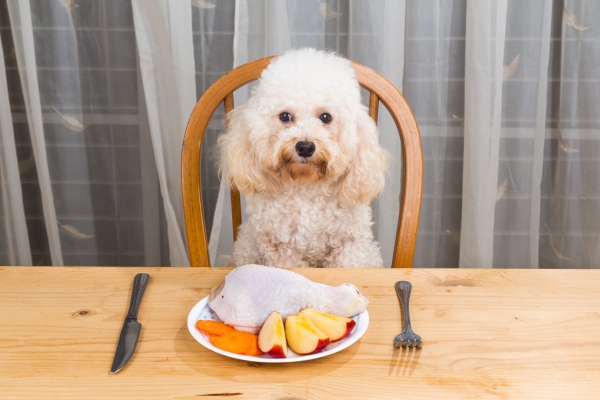
A few weeks ago, I saw Tina, an 8-year-old Goldendoodle, for a follow-up appointment after diagnosing her with diabetes in dogs. Understandably, Tina’s mom had a lot of questions about caring for a dog with diabetes.
She was worried about diabetic ketoacidosis in dogs, and she had concerns about what to do if her diabetic dog won’t eat. Plus, she wondered what human food and treats she could still give her dear dog.
If you recently discovered your dog has diabetes, you probably have some of the same questions and concerns. I have written other blogs to address the first two topics, so let’s focus on the last one—”What human foods can I feed my diabetic dog?”
We will take a look at which human foods are diabetic-friendly (and which ones are not). Plus, I’ll discuss some treats and supplements for diabetic dogs.
Why does it matter what I feed my diabetic dog?
But first, let’s discuss how eating impacts your diabetic dog’s blood sugar. As your vet has probably explained to you, your dog’s body breaks the food he or she eats into its components, including glucose (i.e. sugar). Some foods are going to dump a lot of sugar into the blood quickly, and others will release the sugar more slowly.
Normally, in response to eating, the dog’s pancreas would secrete insulin, a hormone that lowers blood sugar by driving glucose into the cells. This is a good thing because the body functions best in a narrow range of blood sugar levels. And the glucose needs to get inside the cells so that it can be used as cellular energy.
Diabetic dogs need insulin and should eat two meals a day
However, since a diabetic dog’s pancreas isn’t producing insulin, he or she needs insulin injections as a “substitute pancreas.” This works ok, but it isn’t going to be quite as good as the real deal (i.e. the dog’s pancreas). Thus, the composition of the food the dog eats, and when he or she eats it, plays into how well the insulin injection can control a diabetic dog’s blood sugar.
Typically, your vet will have you feed your dog first. And then he or she will have you give a set amount of insulin (the same amount each time) once you ensure your dog has finished the meal. Since long-acting insulin works for about 12 hours, vets usually recommend feeding a diabetic dog two distinct meals a day (12 hours apart) and administering insulin twice a day. This strategy can help prevent dangerous blood sugar spikes or drops, especially when the dog gets a consistent composition and amount of food at a consistent time.
Diabetic dogs have specific nutritional needs
As alluded to, the type of food you feed your diabetic dog helps regulate blood sugar. Most of the time, this is a diet that is high in fiber, low in fat, low in calories, and medium to high in protein. Some dogs do best on prescription diabetic dog food. Others may be successful on an over-the-counter diet that fits those parameters. It is a matter of finding what works best for your particular dog.
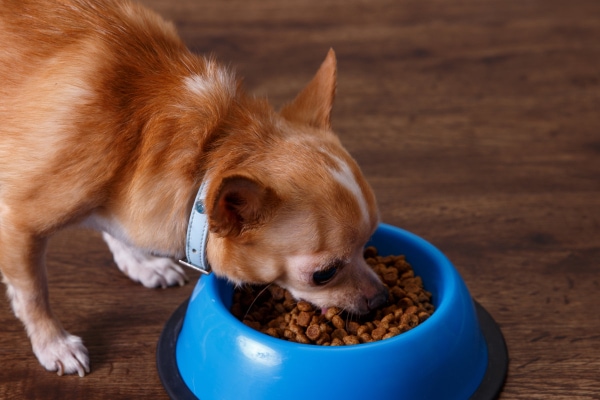
I know making these changes to your dog’s diet can be difficult, especially if your dog is used to getting table scraps. But, the good news is that there are some human foods you can still safely feed your diabetic dog to keep meal times fun.
Without further adieu, let’s tackle some FAQs about which human foods are good for diabetic dogs.
Can diabetic dogs eat meat?
First, we will address meats since they tend to be high on the list of foods that people want to give their dogs.
Can a diabetic dog eat chicken breast?
One of the most common foods people ask me about is chicken breast. And I usually tell them that, yes, chicken is safe for diabetic dogs to eat. Chicken is an excellent source of protein and nutrients for your dog. Also, it has a lower fat content than other meats like beef or pork.
However, if you are going to have your diabetic dog eat chicken breast, cook it without butter or seasonings. And remove the skin. These cooking instructions are important because butter and seasonings are a source of fat, oils, and carbohydrates, and the skin is high in fat. These “extras” may negatively influence your dog’s blood sugar. Plus, some seasonings contain ingredients (e.g., garlic or onions) that are toxic to dogs.
What meats should I avoid giving my diabetic dog?
While chicken is a safe option for your dog, there are some meats that your diabetic dog should not eat. The most important ones to avoid are beef and pork products like:
- Ground beef
- Beef burgers
- Pork chops
- Bacon
These meats can be problematic due to their high-fat content (and therefore high-calorie content). Diabetic dogs need to maintain a healthy dog body condition score (BCS) to help with blood glucose control, so they don’t need the extra calories. Plus, high-fat meals can slow down digestion, which makes it more difficult for insulin to work at the optimal time.
Finally, but perhaps most importantly, these fatty foods put your dog at risk for pancreatitis in dogs. This is a potentially life-threatening inflammation of the pancreas which can cause vomiting, diarrhea, and abdominal pain. Diabetic dogs are already prone to pancreatitis, so adding another risk factor in the form of fatty foods is definitely not a good idea.
Other than chicken, which meats can I feed my diabetic dog?
If you need a meat source to feed your diabetic dog that is safe (but not chicken), some other options include turkey, fish, and beef liver.
Turkey is a great substitute for dogs who don’t eat chicken. It is high in protein and low in fat. But, if your dog is allergic to chicken, it is possible that he or she might be allergic to turkey as well.
In these cases, fish (like salmon) can be a safe meat for your diabetic dog. Salmon is lower in cholesterol than red meat and low in fat—making it a great choice.
Another potential option is beef liver. While, as we discussed, beef is a high-fat food, beef liver is actually very low in fat and calories. This makes it a low glycemic index food. (Glycemic index gives an indication of how fast foods make blood sugar rise, with “high” foods creating a rapid rise and “low” foods creating a slow rise.) Plus, beef liver is very high in vitamins and minerals, which is a great added benefit.
What treats can I give my diabetic dog?
Speaking of the glycemic index, typical dog treats that you find on your local grocery store shelf tend to be higher in sugar. Therefore, many are considered high-glycemic foods. This can make it difficult to find treats for dogs who are diabetic.
Conveniently, some of the dog food companies that make diabetic dog food also make diabetic dog treats. These treats are usually in a biscuit or cookie form and have a similar formulation to prescription dog food. In other words, they are lower in calories, don’t have added sugars, and can be easily metabolized by your diabetic dog. Also, since they come premade, many owners find them easy and convenient to give their dogs.
If you are interested in these types of treats for diabetic dogs, I suggest asking your veterinarian for recommendations. But remember, even if they have your vet’s seal of approval, you still need to limit the number of treats your dog gets. Especially for diabetic dogs, treats should make up less than 10% of your dog’s daily caloric intake.
Can diabetic dogs eat rawhides?
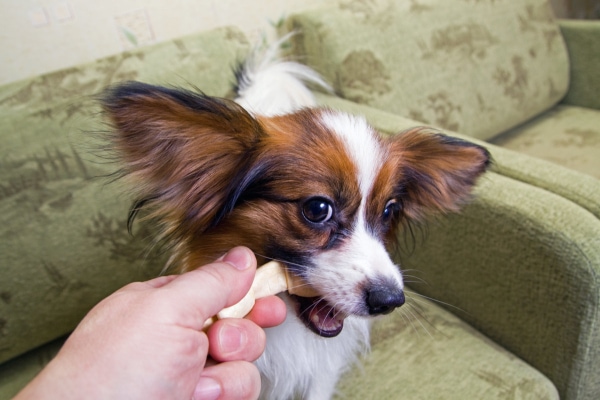
When talking about treats, many of my clients also ask me about rawhides. In general, I am not a big fan of rawhides for dogs (even non-diabetic dogs). There are several reasons why I feel this way:
- Rawhides can fracture a dog’s tooth (which is painful and can lead to a dog tooth abscess and/or necessitate a dog tooth extraction).
- Rawhides are not easily digestible. I have seen dogs swallow large pieces and end up with them lodged in the esophagus, stomach, or intestines.
- Flavored rawhides can contain ingredients that may lead to an upset stomach or pancreatitis.
- Rawhides can be very calorie dense (According to a Tufts University Cumming’s School of Veterinary Medicine article discussing whether rawhide chews cause weight gain in dogs, a 2-inch by 6-inch by 1/8 inch rawhide chew contains 50 to 100 calories.)
This last bullet is especially important for diabetic dogs. Remember, when asking “What foods can I feed my diabetic dog?”, we are selecting ones that are low in calories. In my book, this makes rawhides a definite “no” for diabetic dogs.
What are some good chews and toys for diabetic dogs?
Once I tell dog parents that rawhides are not a good option for their diabetic dog, their next question is usually, “What chew is a good option then?”
Because managing diabetes also means managing calories, I really like to recommend chews that are not food-based. You can find information on multiple chews that fall into this category in my article on safe chew toys for dogs.
But, I also understand that some dogs may not enjoy chewing on “non-food” treats. If this is your dog, one of my favorite solutions is to put some of his or her diabetic-safe dog kibble in a Kong toy. This encourages your dog to play and chew with the toy. And you are offering a food reward that you already know is safe.
However, if the Kong doesn’t work for your dog either, my next solution is to try offering your dog small amounts of vegetables that are safe for diabetic dogs.
Which vegetables are safe for diabetic dogs?
In general, I think vegetables are a great food and treat option for dogs. However, while I have a detailed list of vegetables dogs can eat, not all of these vegetables are the best choice for diabetic dogs. Let’s go through some of the most common ones I get asked about.
Carrots
If you are wondering if diabetic dogs can eat carrots, the answer is yes! Carrots are very low in calories and have many vitamins and minerals that are beneficial for your dog. Also, carrots are sweeter-tasting than many other veggies, making them more palatable to dogs. And as an added benefit, carrots are crunchy when fed raw. This makes them a great chew for your dog too.
However, they do have a higher sugar content than other vegetables, so carrots should be fed to diabetic dogs in moderation.
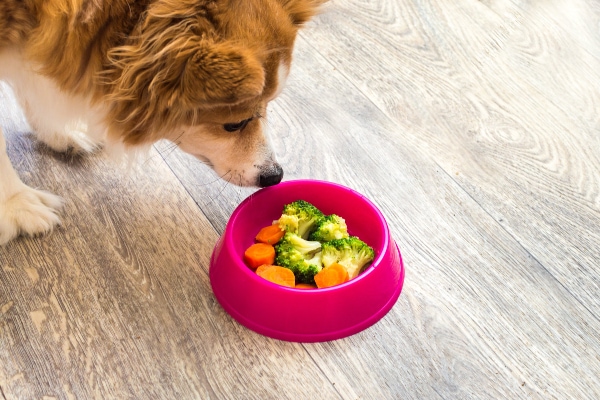
Broccoli
This flowery, green vegetable is an excellent veggie snack for diabetic dogs. Broccoli has a very low glycemic index, so it won’t raise your dog’s blood sugar quickly. Also, it is extremely high in fiber, which can actually help a dog with diabetes.
In addition to using it as a treat, you also can give broccoli to your diabetic dog as part of a meal if he or she is on a diet. Often, when trying to help dogs lose weight, owners worry about them being hungry. Broccoli is very filling, and it can help your dog feel full even after a smaller meal. (Just be sure to serve bite-sized pieces so they don’t become a choking hazard.)
Sweet potatoes
While sweet potatoes are delicious and can be a great option for many dogs, I don’t recommend letting your diabetic dog eat them. They are high in fiber (which is a good thing), but they have a very high sugar content. This makes sweet potatoes high on the glycemic index, meaning they may cause your dog’s blood glucose to increase rapidly.
Potatoes
Just like sweet potatoes, regular potatoes should be avoided in diabetic dogs. They can cause your dog to have blood sugar spikes too.
Celery
Unlike potatoes and sweet potatoes, diabetic dogs can eat celery. It is low in calories, fat, and cholesterol, making it a great treat for dogs with diabetes, or for those who are on a diet. However, celery is not as flavorful as some of the other vegetables. So, don’t be surprised if your dog isn’t interested in this healthy green treat.
Cucumbers
Technically, diabetic dogs can eat cucumbers because they are low in calories and starch. This means cucumbers aren’t going to significantly affect your dog’s blood sugar. However, cucumbers can be dangerous for dogs because their shape makes them a choking hazard. And if your dog eats too many of them at once, they can cause stomach upset or even blockages in the digestive system.
Therefore, while nutritionally speaking, cucumbers are safe, I recommend avoiding them as much as possible. If you are going to give your diabetic dog some cucumber, be sure to cut it into little pieces, and only feed small amounts.
Can diabetic dogs eat fruit?
After talking about all the vegetables that diabetic dogs can and can’t have, I often get asked about fruits. In general, you have to be more careful when feeding fruits to your diabetic dog. Many fruits are higher in sugar and starch, which can pose a problem for blood glucose regulation. However, some fruits have good levels of fiber for dogs with diabetes.
Apples
Apples are a perfect example of a fruit that has wonderful nutritional benefits but might not be a good pick for diabetic dogs. I love apples because they are an excellent source of vitamins A and C—making them very good for the immune system. But while they are high in fiber, they are also very high in sugar, which isn’t great for diabetic dogs. With this heavy sugar content, I recommend only giving your diabetic dog occasional tiny bites of an apple.
Bananas
While bananas are a tasty treat for dogs, I usually recommend not letting diabetic dogs eat them either. Bananas are full of vitamins and minerals that your dog needs. However, the sugar content, and therefore glycemic index, of bananas is high. Even in dogs who are not diabetic, I always advise giving bananas in moderation as an occasional small treat. So, for our furry friends with diabetes, it is definitely safer to avoid bananas altogether.
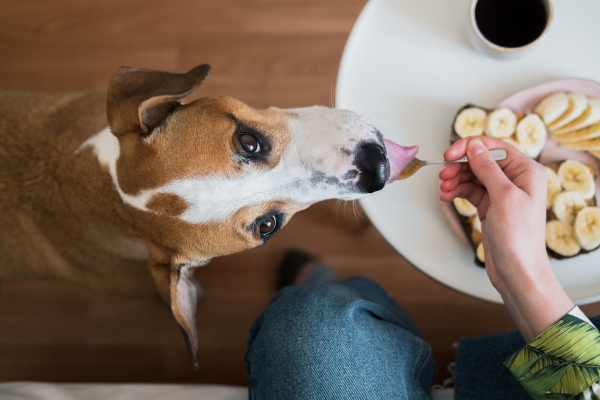
Watermelon and strawberries
Unfortunately, while watermelon and strawberries are delicious, diabetic dogs cannot eat them. Just like bananas, these fruits are too high in sugar to be a good idea.
Blueberries
Unlike the previous fruits, this little blue fruit can be eaten by diabetic dogs. Blueberries are excellent sources of vitamin C and fiber. The high fiber makes them easier for diabetic dogs to digest and use in the body. Additionally, they are lower in sugar than some other fruits.
However, blueberries do still have more sugar than vegetables or your dog’s diabetic dog food. For this reason, they should be fed in moderation as an occasional treat.
Pumpkin
If I was going to pick an ideal fruit for a diabetic dog, I would have to pick a pumpkin. Canned pumpkin for dogs has many nutritional benefits. For example, it contains a lot of important nutrients like vitamin A. But for diabetics, I specifically prefer it over other fruits because pumpkin has a very high fiber content. This makes it a safe food that diabetic dogs can eat. It is also low in calories, which can help diabetic patients lose weight.
The most important thing to remember when feeding pumpkin to dogs is to never use canned pumpkin pie filling. You should only feed fresh pumpkin or pure, canned pumpkin. Pumpkin pie filling has added seasonings that can be toxic to dogs. Additionally, it often contains an artificial sweetener called xylitol (i.e. birch sugar), which is extremely toxic to dogs.
What other human food can I feed my diabetic dog?
Now that we have covered the larger categories of meats, fruits, and veggies, let’s discuss other common human foods that you might want to feed your diabetic dog.
Eggs
Diabetic dogs can eat eggs! They are an excellent source of protein for your dog. Eggs also have other nutrients that are important for your dog’s health. And unlike many of the foods we just discussed, eggs aren’t very high in sugar. This makes them less likely to impact your dog’s glucose levels.
When feeding your dog eggs, you should always fully cook them to reduce the risk of salmonella. It is okay if they are scrambled or boiled. But you should avoid adding seasonings or butter, which could be harmful to your dog.
White and brown rice
While white rice is often recommended as part of a bland diet for dogs, you should avoid giving it to dogs with diabetes. It does not provide much nutritional value for dogs, so it would mostly be empty calories that have a higher glycemic index than is recommended.
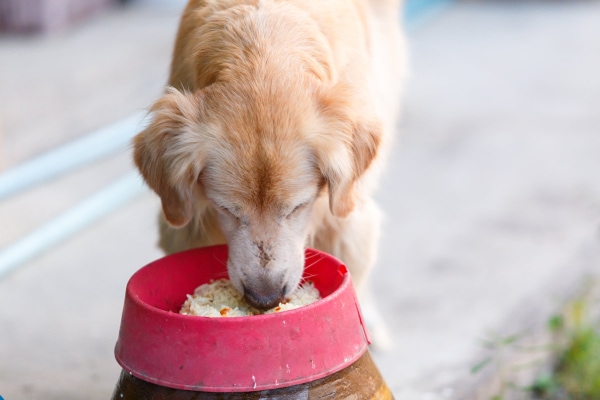
Brown rice is a little more nutritious than white rice, but can still cause blood sugar levels to rise if diabetic dogs eat it. Therefore, I usually advise my clients to avoid rice in general.
Cheese
While dogs love cheese, it has a higher fat and cholesterol content than I prefer for diabetic dogs. However, diabetic dogs can eat some low-fat cheeses in very small portions. Cheese can be an excellent source of protein, vitamins, and minerals (and a good way to hide pills if your dog won’t take pills). Therefore, if you want to give your diabetic dog the occasional low-fat cheese snack or use a tiny bit of cheese to get your dog to take his or her medication, you can often safely do so in moderation.
Peanut butter
When clients ask me if diabetic dogs can eat peanut butter, I warn them that there isn’t a straightforward answer. This is the case because there are so many variations of peanut butter. Some have a higher sugar content and should be avoided. Other types (e.g., high-quality or natural peanut butter) are less likely to have extra additives, making them somewhat safer for diabetic dogs.
These types of peanut butter can serve as an excellent source of protein and nutrients for your dog. However, it is important to feed peanut butter in moderation because the fat content could affect your dog’s sugar levels or cause pancreatitis.
If you are considering offering peanut butter to your dog as a treat, I recommend discussing it with your veterinarian first. He or she can help you determine if the brand you are using is safe for your diabetic dog, and how often it is okay for your dog to have it. (Also, always check the label for the toxic sugar substitute xylitol before giving peanut butter to your dog.)
What about supplements for diabetic dogs?
Finally, let’s briefly touch on supplements for diabetic dogs. I won’t get into this too deeply because there are so many different supplements available for a wide range of problems. However, I do want to touch on two that tend to come up more often—coconut oil and joint supplements.
Can diabetic dogs have coconut oil?
I know that coconut oil is popular among dog parents as a way to improve skin and coat health, support the immune system, help with arthritis, and more. However, generally, I do not recommend giving coconut oil to diabetic dogs. While coconut oil is lower in sugar than some other products, it is very rich in saturated fat. The high-fat content can lead to weight gain or pancreatitis—both of which we want to avoid in our diabetic dogs.
Therefore, I recommend asking your veterinarian to recommend a safe alternative to coconut oil for your diabetic dog.
Can diabetic dogs take joint supplements?
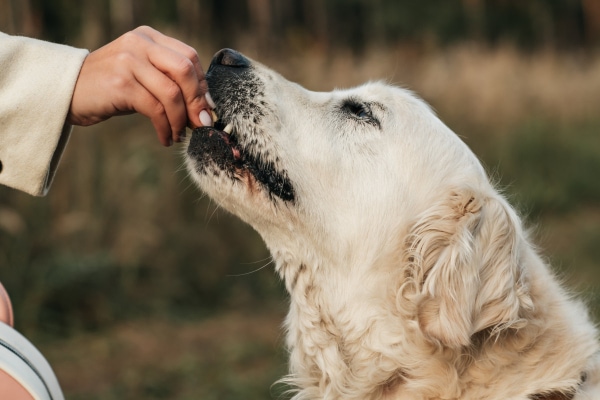
Often, dogs are diagnosed with diabetes between 7 and 10 years old, which means there is a good chance they have some osteoarthritis in dogs too. This leads to many clients asking me about the safety of joint supplements for dogs who are diabetic. Thankfully, many joint supplements are safe for diabetic dogs. But it is always best to run any new supplement past your veterinarian since he or she knows your dog’s medical history.
My favorite product to recommend for arthritic dogs (or other diabetic dogs with joint disease) is Dr. Buzby’s Encore Mobility™ hip and joint supplement.
Encore Mobility is a natural “super supplement” made from New Zealand deer antler velvet and green lipped mussel for dogs. I love this supplement for many reasons, including because it is safe for diabetic dogs. And as an added bonus, dogs love the taste!
When in doubt, ask your vet!
While I’ve covered a wide range of foods from veggies, fruits, and meats to supplements and treats, I know I did not address every food you might want to offer your diabetic dog. And I understand that navigating life with a newly-diagnosed diabetic dog can be difficult. Remember though—you don’t have to figure it out alone!
Your veterinarian can be an excellent resource as you sort out what you should—and should not—feed your diabetic dog. If you ever have specific questions about a food or treat, please ask your veterinarian.
I recommend bringing the actual product (e.g. supplement, jar of peanut butter, etc.) to the vet clinic with you, or taking a picture of the label and nutrition/ingredient information. This can help give the vet the information needed to make an informed decision about a specific food, treat, or supplement.
Food is an important part of many dogs’ lives (and often your bond with them). And that doesn’t have to stop being the case just because of a diabetes diagnosis. There are ways to maintain that aspect of your relationship while helping keep your dog’s blood sugar under control. My advice would be to use what you have learned from this article, consult your vet when you have questions, and keep on enjoying life with your diabetic dog.
What is your dog’s favorite diabetic-safe snack?
Please comment below


Our Mini Aussie was diagnosed with diabetes a few months ago. We let her lick plates (yes, I’m ashamed). She was almost 10 lbs overweight. We’ve been very consistent with her meds and meals. No more licking plates. At first it was hard to find treats; so many of them have grains and even sugar! I found two she really likes: dehydrated liver and Icelandic Beef and Lamb Collagen Puffs. They are crunchy. The last vet visit, she had lost the extra weight and the vet said, “I like the look of this dog!” It’s not easy taking care of her (I’m the only person who can give her the injection) but she’s doing well.
Hi Janice,
I understand how hard it can be to make changes and establish healthy habits. It sounds like you are doing everything right and your girl is reaping the benefits. I am confident you will be able to maintain this new lifestyle for your pup. Wishing you all the best and keep up the good work!
My 4 lb 14 year old Yorkie has diabetes. Just diagnosed. She also has the most awful teeth you can imagine. She has lost all of her top teeth except her canines and they are very lose. My vet has never wanted to put her to sleep since she was spayed. It was a night mare! She stopped breathing for no reason several times. After she couldn’t wake up from sedation. She has always been very sensitive to things. . Flea shampoo,flea collar, certain shampoos. My point is she has always been such a DIVA and even at her age and health she is spiced, happy and demanding! I’m more worried about her teeth! They all need pulled.. I don’t want her put to sleep to remove!
Hi Tajuana,
I understand your concern for your feisty girl with these dental issues she is dealing with. My best advice is to schedule a consultation with a veterinary dentistry specialist. They may have ideas about treatment or therapies that are not widely known or available in general practice. You are doing a great job advocating for your senior girl’s health and well-being and she sounds like such an amazing little pup. Wishing you both nothing but the best and give your sweet girl a hug for me!
Mu 12 year old Shih tzu was diagnosed with diabetes in Sept of last year. We seem to have a good handle on it. I’ve cut out ALL treats (much to his dismay) though he was not overweight. I just don’t want to upset the delicate balance we’ve achieved. However, he hates his nail trimming days, and I used to reward him with a yogurt filled kong. I’ve cut that out as well (also much to his dismay). He loved his Kong, and it would keep him occupied for awhile. What can i substitute instead? It probably holds a good 2 Tablespoons of yogurt or other treat. Someone suggested whipped cream? but it has sugar….Any ideas? I really liked your article and am thinking about scrambled egg, but that would be a whole egg.. Sounds like a lot for my little guy (17#)
Hi Sandy,
It sounds like you are doing a great job of managing your pup’s diet and getting his blood sugar stabilized. While everything he eats will trigger an insulin response, there are foods that will keep his blood sugar lower than others. Protein and fiber are two good options. You could see if your boy would be interested in frozen green beans. Or if you need to use the Kong, you could try filling it with a meat or vegetable baby food. Kongs can even be frozen before offering it to your guy if you need them to last a bit longer. Hoping these ideas will be helpful. Keep up the good work and give your sweet boy a hug for me!
my dog waylon is a 12year old mix black mouth curr an Australian sheep dog, he has diabetes from all my neglect of giving him table scraps .he’s 70lb.looks great .I walk him every evening for 30 minutes. he eats 2 good meals a day now. but my issue is the vet. keeps trying to find the right dosage of insulin .I started with 17units every 12 hours but then the vet went to 16 units cause his level was 70 way to low now I’m trying 14 units starting today 7-2 -2024 but I noticed waylon will lay on the carpet off an on for like a hour at a time .is that okay?
Hi Mike,
I understand your concern for Waylon as you try to get him well regulated on insulin. This can be a tricky process and I applaud you for paying such close attention to his symptoms and behavior. Unfortunately, without seeing him myself, it is hard to make specific conclusions about this new behavioral pattern. I would mention it to your vet and see if they think a recheck or any follow up lab work is needed. Waylon is lucky to have you taking such good care of him. Wishing you continued success and keep up the good work!
our 11 year old malti/westie mix was diagnosed with diabetes. she seems to be at 400 most of the time. she is also hungry all the time. I feed her chicken,grn beans,boiled eggs for snacks in-between canned dog food for breakfast and dinner. what other vegetables can she eat? I also make her liver snacks. could I please get your newsletter?
Hi Lynn,
I am sorry your girl is having so many issues since receiving her diabetes diagnosis. The extreme hunger makes me wonder if something else isn’t contributing to her condition. Has your vet mentioned checking for Cushing’s disease? I am not sure what other foods to recommend as it can be tricky to balance a diet for diabetic dogs without the input of a veterinary nutritionist. Your vet can schedule a consultation with a specialist if needed. Here is a link to another article with more ideas of vegetables that are safe for dogs: 14 Vegetables Dogs Can Eat (And May Just Love)
And here is the link to sign up for the newsletter: https://toegrips.com/newsletter/
Hoping you can find the answers you need to ensure your girl stays happy and healthy for as long as possible. Best wishes to you both!
Hi Dr. Buzby,
My Weimaraner was diagnosed with diabetes in October, 2023. At that time his weight was 92 lbs. His blood glucose was 600. He was started on 20 U of Vetsulin 1X/day after breakfast. His insulin dose was decreased over time as he continued to lose weight and blood glucose levels dropped. He did have one hypoglycemic seizure in November that stopped after applying corn syrup to his gums. Starting December 1st his insulin was discontinued. He is active and happy at home but continues to lose weight (Feb 1st 71 lbs, Blood glucose 106). His appetite is excellent. Two times /day He gets 1 1/2 cups of chicken breast, 1/2 cup dry food, 1 large tbsp of wet food, 1/4 cup of green beans , 1 tbsp pumpkin, Any advice is appreciated! and thank you.
Hi Barbara,
Wow! You have done such a great job with your Weimaraner. What a blessing his diabetes is in remission, and he has lost weight. I understand your concern over the continued weight loss, but without examining your boy myself it is hard to make specific conclusions and recommendations. It is possible he is still shedding unwanted pounds and has not reached his ideal body weight. To know for sure, you would need your vet to evaluate his body condition score. If you have any concerns about his diet, I encourage you to reach out to a veterinary nutritionist. They can help ensure his meals are balanced, nutritionally complete, and meet his specific medical needs. Wishing you both nothing but the best. Keep up the good work!
My 6yr old Chorkie was diagnosed with diabetes, 2wks ago, I had already invested in snacks. I feed her Bandland Ranch dog food and Sam,s club dried chicken breast. I’m on a budget so I make her food so my other dog doesn’t have to change her treats too much.. I use brown rice, spinach, pumpkin lentils and brown rice I alternate fresh cranberries and blueberries along with carrots and frozen peas. The meats I use are chicken breast or turkey. I am so nervous with this situation just want to keep her going.
Hi Pam,
I am sorry you are facing this difficult diagnosis in your little pup. While I am a big fan of home cooked diets, it might be a good idea to talk to a nutritionist to make sure the meals you are feeding are a good fit for a diabetic. While the ingredients sound very healthy, they may contain more sugar than is ideal with all the carbohydrates and fruits. Your girl is very lucky to have you taking such good care of her. Wishing you both all the best and keep up the good work!
Please send newsletter. My dog was just diagnosed with diabetes and any helpful tips would be greatly appreciated. Also from articles I read I am told that she will no live past two years. Is this reliable information? Thank you for this site
Wanda
Hi Wanda,
I can only imagine how worried and scared you must be with your dog receiving this difficult diagnosis. Try not to let this situation be overwhelming. Many dogs with diabetes are well controlled and go on to live long happy lives. While diabetes (or any chronic condition) may shorten your dog’s lifespan a bit, there is no reason to assume she only has 2 years left. Here is a link to an article with more information: Diabetes in Dogs: The Ultimate Guide
Hoping you can partner with your vet to ensure your sweet girl remains as healthy as possible. Wishing you both the best!
Here is the link to sign up for the newsletter: https://toegrips.com/newsletter/
Hi,
my 11 year old dog that has Cushing’s was also just diagnosed with diabetes.
Can you please add me to your newletter list?
Hi Corine,
I am sorry your pup is dealing with both of these difficult issues at the same time. Here is the link to the sign-up page for the newsletter: https://toegrips.com/newsletter/
Wishing you both the best as you navigate this tough road ahead. ♥
muffrey is 9 years old now and has been diabetic for 3 1/2 years the first year was was a lot of trial and error and was very concerned with her health. I gave up on the canned food and the kibble she was going blind very quickly although there is no hope for her blindness and feeling pretty helpless for my baby girl. she was depressed no energy and became very finicky with her food. I took a chance an ordered The Farmers Dog Food. after a few days her whole demeanor changed she loves the food, her energy level was good her coat and skin is like it should be and no more depression
we took her on a trip to Wyoming and with her blindness I wasn’t sure how the long road trip would effect her but what a little trooper. she even learned to respond to commands..such as go right ..go left… forward….back ..go back…..in addition the only snacks that she gets are a few blueberries…or fresh broccoli cooked for 2 minutes Ifeel confident that or Muffey will live for a few more years. ..Thank you Dr Busby’s first your article
Hi Penny,
I am glad to hear that Muffey is doing so well and is enjoying her senior years. Thank you for sharing your experience with us. It is very refreshing to read a success story! Wishing you and your sweet girl continued health and praying you have many happy years ahead. ♥
I was struggling to get sugar levels for my dog and then invested in a human glucose sensor. Made life alot easier and Im hoping when the levels even out I will just need to use one every 3-6 months
Hi Kirsty,
I have heard of people using human glucose meters for dogs, but this can be dangerous. They are calibrated for the composition of human blood and canine blood is not the same. Due to this the results can be a bit inaccurate, but you can follow the trends. They do make glucose meters for dogs and there are also many vets starting to use continuous glucose monitors too! One that has shown good results is the Freestyle Libre II. Wishing you continued success in the management of your pup’s diabetes!
Hi Dr Buzby
I have a newly diagnosed diabetic toy poodle 3 weeks ago. He was 6.2 kg in August and now weighs 4.8 kg. I am feeding him two meals a day of chicken and Royal Canin diabetic kibble. I have yet to do a glucose curve as he really fights me with the injection so haven’t wanted to stress him more yet. Any advice on what I can feed him to get him to put on a bit of weight? Please add me to you news letter distribution list. Kind regards.
Hi Jo,
I am sorry your Poodle has received this difficult diagnosis. Have you talked to your vet about this weight loss your pup is experiencing? Before trying to alter his diet, it would be best to rule out other issues and make sure his insulin dosage is ideal. I have passed your information on to the team to get you added to the newsletter list. Wishing you and your sweet boy many happy days ahead.
newly diagnosed diabetic 6lb dog.
please send any news letters..
thank you
Hi Shannon,
Sorry to hear that your pup was recently diagnosed with diabetes. I hope he or she is doing ok now! You’ve been added to the newsletter list so you should start receiving them shortly. If you are interested in reading any of our other article on diabetes, I’ve included links to them below:
1) Diabetes in Dogs: The Ultimate Guide
2) My Diabetic Dog Won’t Eat: Now What?
3) Diabetic Ketoacidosis in Dogs: A Vet’s Guide to DKA in Dogs
My diabetic dog Molly won’t eat about anything. She’s very, very picky. I’m feeding her cooked chicken breast now (plain) but she just tolerates it (I basically don’t cook at all or know how). I’m at my wits end to find something she’ll happily eat!
Hi Kim,
I just responded to your other comment on the diabetes article. Hoping you will see it too. I am sorry Molly is a bit of a picky eater. Have you tried some of the fruits and veggies mentioned in this article? Make sure your vet is aware of her diet issues. They may have some good advice or tips to try. You are doing a great job advocating for your sweet girl. Keep up the good work!
my dog kalika is a pug and she is just over 11 yrs old now and has been diagnosed with diabetes for about 4 yrs now. my vet told me that I could use human novolin insulin on her as it is cheaper ( as we are on a very tight budget) as well as a human reli on meter works just as good as a dog meter. I had a dog meter but the sticks got very pricy.
we were making her food homemade with chicken, frozen veggies and rice but that got to be to much as we had a baby 4 yrs ago. we have gone through so many different kinds and types of food as she is highly picky and sensitive ( allergies and ear problems from them ) to many things but we are now feeding her pure balance salmon and peas dry dog food and she absolutely loves it. we do also give her treats, was all natural chicken pieces but they got expensive. she also loves so many veggies I have to share with her.
ever time I take her to the vet her blood work is great unless she is sick but we get that fixed with an antibiotic. she also has cataracts and glaucoma from the diabetes.
the year she was diagnosed with diabetes she ended up having 3 different ticks latch on to me her within a two week span. then a month or so later she was diagnosed.
of course I did research on the diabetes and insulin and everything else my vet has said, as I just wanted to be sure and safe because she is my baby girl and so far so good. she is an amazing little girl and everyone loves her as much as she loves them.
Hi Melissa,
I am glad to hear Kalika is doing well and is still living her best life. What a blessing she responded favorably to the treatment, and you have been able to find cost effective solutions for her care. Thank you for sharing her story with us. Wishing you continued success and many happy days ahead. Bless you and your sweet girl!
Hi. I’m Paula and I have a diabetic dog. He was diagnosed 8 years now. I make quinoa with the chicken broth from the chicken, add chicken and peas, and he loves it. For treats I found Blue health bars, the one with yogurt or bacon, egg and cheese. He unfortunately had to get insulin shots twice a day, but at almost 13, he’s so freaking healthy!
Hi Paula,
I am glad you have found some healthy foods your dog enjoys. Thank you for sharing your experience with us. Give your sweet boy a hug for me and keep up the good work!
Lettuce and green beans